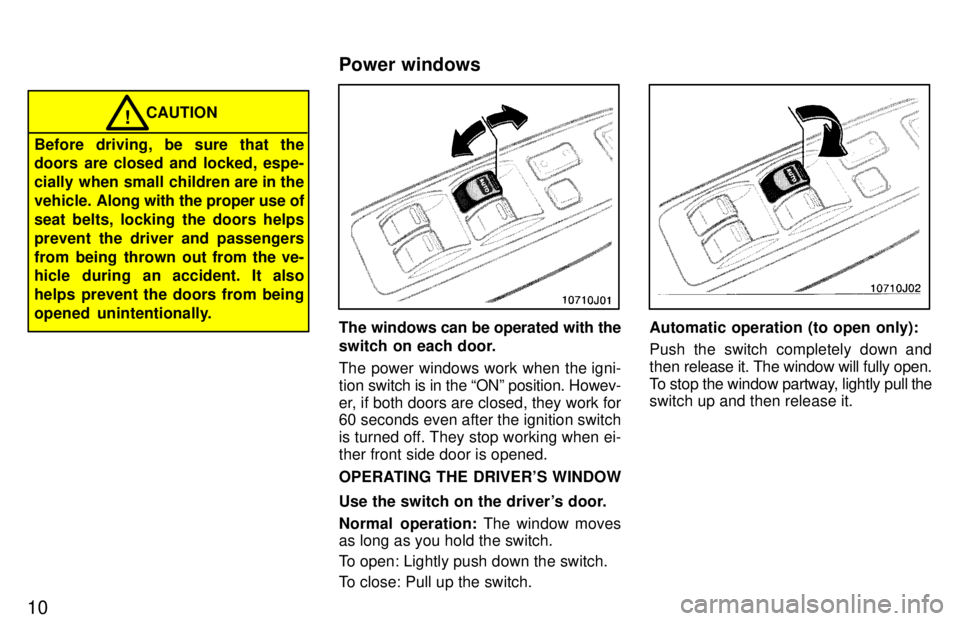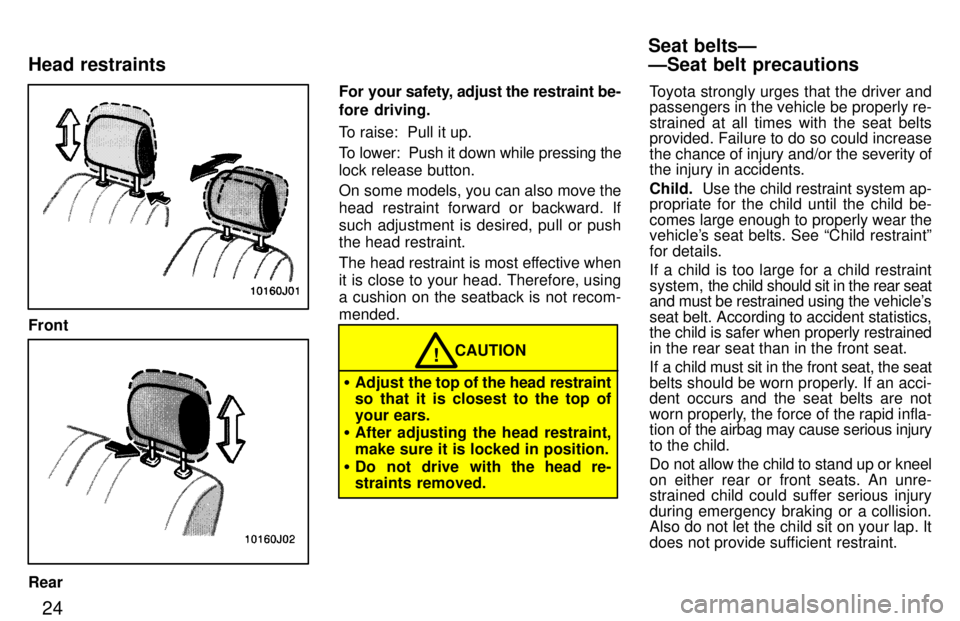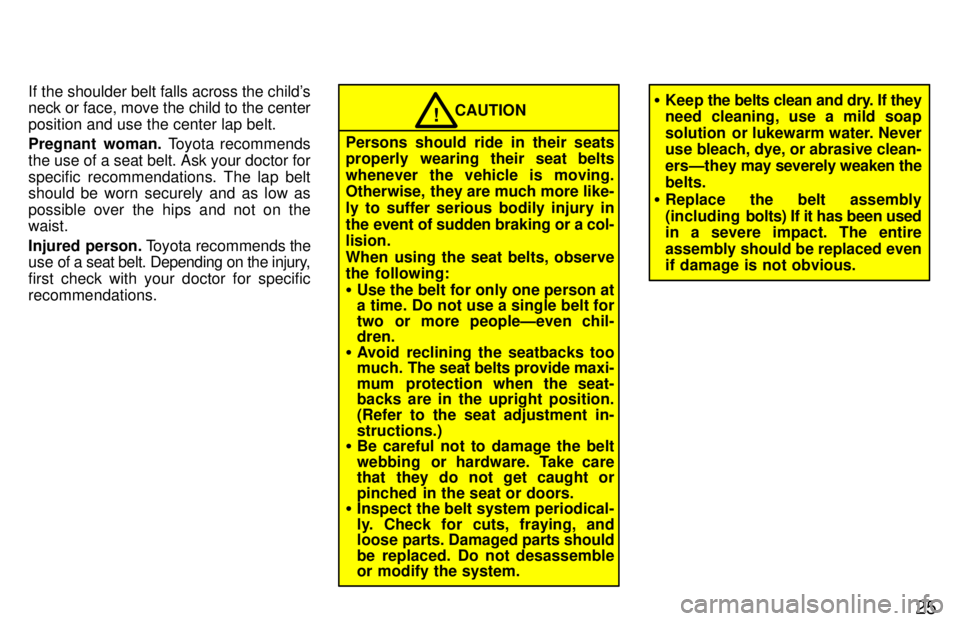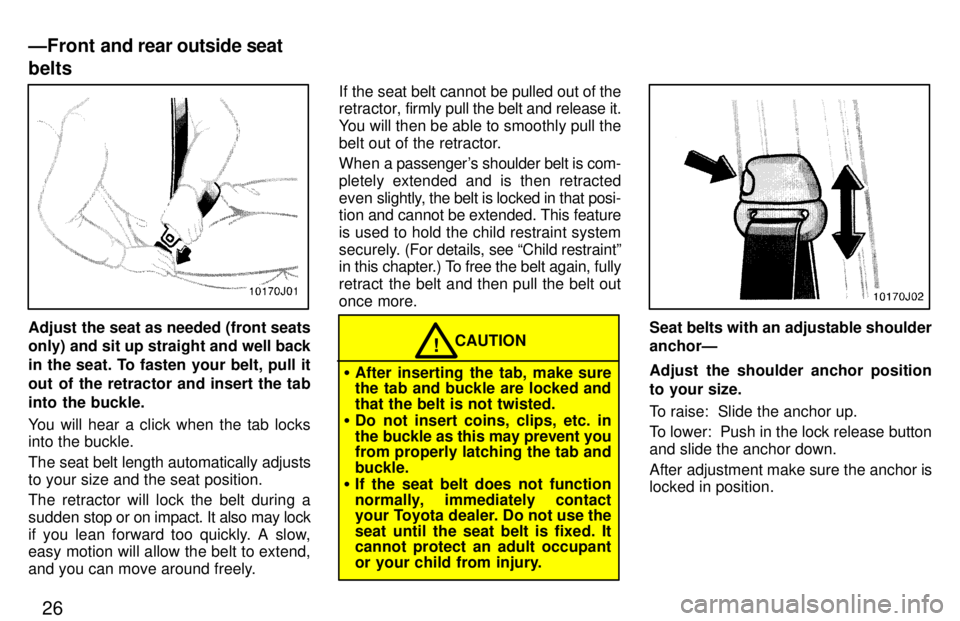Page 6 of 223
Indicator symbols on the instrument panel5
Unengaged Parkº warning light *1
Brake system warning light *1
Seat belt reminder light* 1
Discharge warning light* 1
Low oil pressure warning light* 1
Malfunction indicator light* 1
Low fuel level warning light * 1 Open door warning light*
1
SRS airbag warning light* 1
Automatic transmission fluid
temperature warning light* 1
Turn signal indicator lights
Headlight high beam indicator light
Over-drive indicator light
Anti-lock brake system warning
light * 1 Low windshield washer fluid level
warning light*
1
Page 11 of 223

10
CAUTION!
Before driving, be sure that the
doors are closed and locked, espe-
cially when small children are in the
vehicle. A long with the proper use of
seat belts, locking the doors helps
prevent the driver and passengers
from being thrown out from the ve-
hicle during an accident. It also
helps prevent the doors from being
opened unintentionally.
The windows can be operated with the
switch on each door.
The power windows work when the igni- tion switch is in the ONº position. Howev-
er, if both doors are closed, they work for 60 seconds even after the ignition switch
is turned off. They stop working when ei-ther front side door is opened.
OPERATING THE DRIVER'S WINDOW
Use the switch on the driver's door.
Normal operation: The window moves
as long as you hold the switch.
To open: Lightly push down the switch.
To close: Pull up the switch.Automatic operation (to open only):
Push the switch completely down and
then rel ease it. The window will fully open.
To stop the window partway, lightly pull the
switch up and then release it.
Power windows
Page 20 of 223

24
Front
RearFor your s
afety, adjust the restraint be-
fore driving.
To raise: Pull it up.
To lower: Push it down while pressing the lock release button.
On some models, you can also move the
head restraint forward or backward. If
such adjustment is desired, pull or push the head restraint.
The head restraint is most effective when
it is close to your head. Therefore, using a cushion on the seatback is not recom- mended.
CAUTION!
� Adjust the top of the head restraint
so that it is closest to the top of
your ears.
� After adjusting the head restraint,
make sure it is locked in position.
� Do not drive with the head re-
straints removed. Toyota strongly urges that the driver and passengers in the vehicle be properly re- strained at all times with the seat belts
provided. Failure to do so could increase
the chance of injury and/or the severity of the injury in accidents. Child.
Use the child restraint system ap-
propriate for the child until the child be-
comes large enough to properly wear the
vehicle's seat belts. See Child restraintº
for details.
If a child is too large for a child restraint
system, the child should sit in the rear seat
and must be restrained using the vehicle's
seat belt. According to accident statistics, the child is safer when properly restrained
in the rear seat than in the front seat.
If a child must sit in the front seat, the seat
belts should be worn properly. If an acci- dent occurs and the seat belts are not
worn properly, the force of the rapid infla-
tion of the airbag may cause serious injury
to the child.
Do not allow the child to stand up or kneel
on either rear or front seats. An unre-
strained child could suffer serious injury
during emergency braking or a collision.
Also do not let the child sit on your lap. It
does not provide sufficient restraint.
Seat beltsÐ ÐSeat belt precautions
Head restraints
Page 21 of 223

25
If the shoulder belt falls across the child's neck or face, move the child to the center
position and use the center lap belt.
Pregnant woman.
Toyota recommends
the use of a seat belt. Ask your doctor for
specific recommendations. The lap belt
should be worn securely and as low as
possible over the hips and not on the waist.
Injured person. Toyota recommends the
use of a seat belt. Depending on the injury,
first check with your doctor for specificrecommendations.
CAUTION!
Persons should ride in their seats
properly wearing their seat belts
whenever the vehicle is moving.
Otherwise, they are much more like-
ly to suffer serious bodily injury in
the event of sudden braking or a col- lision.
When using the seat belts, observe
the following: � Use the belt for only one person at
a time. Do not use a single belt for
two or more peopleÐeven chil- dren.
� Avoid reclining the seatbacks too
much. The seat belts provide maxi-
mum protection when the seat-backs are in the upright position.
(Refer to the seat adjustment in-structions.)
� Be careful not to damage the belt
webbing or hardware. Take care
that they do not get caught or
pinched in the seat or doors.
� Inspect the belt system periodical-
ly. Check for cuts, fraying, and
loose parts. Damaged parts should
be replaced. Do not desassemble
or modify the system.
� Keep the belts clean and dry. If they
need cleaning, use a mild soap
solution or lukewarm water. Never
use bleach, dye, or abrasive clean-
ersÐthey may severely weaken the
belts.
� Replace the belt assembly
(including bolts) If it has been used
in a severe impact. The entire
assembly should be replaced even
if damage is not obvious.
Page 22 of 223

26
Adjust the seat as needed (front seats only) and sit up straight and well back
in the seat. To fasten your belt, pull it
out of the retractor and insert the tab
into the buckle.
You will hear a click when the tab locks into the buckle.
The seat belt length automatically adjusts
to your size and the seat position.
The retractor will lock the belt during a
sudden stop or on impact. It also may lock
if you lean forward too quickly. A slow, easy motion will allow the belt to extend,
and you can move around freely. If the seat belt cannot be pulled out of the
retractor,
firmly pull the belt and release it.
You will then be able to smoothly pull the
belt out of the retractor.
When a passenger's shoulder belt is com-
pletely extended and is then retracted
even slightly, the belt is locked in that posi-
tion and cannot be extended. This feature
is used to hold the child restraint system
securely. (For details, see Child restraintº
in this chapter.) To free the belt again, fully
retract the belt and then pull the belt out
once more.CAUTION!
� After inserting the tab, make sure
the tab and buckle are locked and that the belt is not twisted.
� Do not insert coins, clips, etc. in
the buckle as this may prevent you
from properly latching the tab and buckle.
� If the seat belt does not function
normally, immediately contact
your Toyota dealer. Do not use the
seat until the seat belt is fixed. It cannot protect an adult occupant
or your child from injury.
Seat belts with an adjustable shoulder anchorÐ
Adjust the shoulder anchor position
to your size.
To raise: Slide the anchor up.
To lower: Push in the lock release button
and slide the anchor down.
After adjustment make sure the anchor is
locked in position.
ÐFront
and rear outside seat
belts
Page 23 of 223
27
CAUTION!
Always make sure the shoulder belt
is positioned across the center of
your shoulder. The belt should be
kept away from your neck, but not
falling off your shoulder. Failure to
do so could reduce the amount of
protection in an accident and cause severe injures in a collision
Adjust the position of the lap and
shoulder belts Position the lap belt as low as possible on
your hipsÐnot your waist, then adjust it to
a snug fit by pulling the shoulder portion
upward through the latch plate.
CAUTION!
� High-positioned lap belts and
loose-fitting belts both could in-
crease the chance of injury due to
sliding under the lap belt during
collision. Keep the lap belt as low
on your hip bone as possible.
� For your safety, do not place the
shoulder belt under your arm.
Page 24 of 223
28
To release the belt, press the buckle-
release button and allow the belt to re- tract.
If the belt does not retract smoothly, pull
it out and check for kinks or twists. Then make sure it remains untwisted as it re- tracts.Sit up straight and well back in the
seat. To fasten your belt, insert the tab
into the buckle.
You will hear a click when the tab locks into the buckle.
If the belt is not long enough for you, hold the tab at a right angle to the belt and pull
on the tab.
CAUTION!
� After inserting the tab, make sure
the tab and buckle are locked and that the belt is not twisted.
� Do not insert coins, clips, etc. in
the buckle as this may prevent you
from properly latching the tab and buckle.
� If the seat belt does not function
normally, immediately contact
your Toyota dealer. Do not use the
seat until the seat belt is fixed. It cannot protect an adult occupant
or your child from injury.
ÐRear center seat belt
Page 25 of 223
29
Remove excess length of the belt and adjust the belt position.
To shorten the belt, pull the free end of the belt. Position the lap belt as low as possible on your hipsÐnot on your waist, thn adjust it
to a snug fit.
CAUTION!
High-positioned and loose-fitting
lap belts could cause severe injuries
due to sliding under the lap belt
during a collision. Keep the lap belt
positioned as low on hips as possible.
To release the belt, press the buckle-
release button.The rear seat belts can be stowed
when not in use.
Seat belts must be stowed before you fold
the seat back. (See Rear seatsÐFold
down rear seatº in this chapter.)
ÐStowing rear seat belts